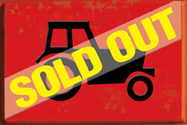
Manufacturers have pushed early order programs for years, but the scarcity of equipment in 2008 may have finally brought the message home to both dealers and farm customers: pre-ordering is here to stay.
Caterpillar chairman and CEO Jim Owens was clearly sending a message to CAT dealers — and perhaps all heavy-equipment retailers — when he told the Wall Street Journal in a March 2007 interview that the construction equipment giant wanted to get away from the automotive model of stuffing dealers' inventories with products.
"We want to keep some dealer inventory out there so they can see it and buy it and try it, but we want to get away from having them carry significant amounts of inventory," said Owens. "If you look back, dealer inventory swings have in every case aggravated the business cycle for Caterpillar. We work overtime to build inventory in the up cycles, and then (in down cycles) help them get it moved by price discounting or other bad practices.
"We've got to convince them that they don't need to hold the inventory. This is a huge cultural change."
If farm machinery dealers hadn't gotten the message previously, equipment shortages in 2008 certainly helped make it a little clearer that the nature of their businesses is changing. Many of the dealers polled recently by Farm Equipment admitted to missing out on hundreds of thousands, if not millions, of dollars, in new equipment sales since the start of the year because they couldn't get the new equipment their customers wanted.
Calling what dealers went through in the past year trying to procure new equipment — everything from row-crop tractors, combines, tillage and hay tools — as a "cultural change" may be putting it mildly. "Cultural shock" would be far more fitting.
Writing on the Wall
Farm equipment dealers shouldn't have been taken off guard by their inability to procure all of the new machinery they desired during the past year or so. For years, the majors and many shortline equipment manufacturers have pushed early order programs (EOPs), but dealers say it's been difficult to persuade farm customers that it's in everyone's best interests to order equipment in advance when there was plenty of it sitting in dealership lots.
But as the worldwide farm economy has picked up steam in the past two years, efforts to convince farmers to place machinery orders early have gained momentum, as well.
In 2008, the market dynamics of farming converged almost perfectly, finally giving manufacturers the muscle they needed to force the issue.
In the U.S., rising commodity prices fueled the grower's need to improve productivity, which gave rise to their need to upgrade equipment and/or buy larger-capacity units. Combine the escalating domestic requirements with skyrocketing global needs for more and better food, along with overseas growers' desire to improve agricultural operations, and the stars aligned perfectly for equipment manufacturers. This gave them the leverage to impose new purchasing disciplines on their retailers — and ultimately on the farmers, themselves.
Add to the equation the falling value of the U.S. dollar, which significantly improved margins on exported products vs. those sold locally, and the basis of the equipment crunch of 2008 becomes a more than a little apparent.
And the shortages weren't limited only to the biggest and most prominent types of machinery. While the scarcity of tractors and combines received the most attention, dealers felt the pinch in nearly every equipment type category, sometimes complaining about not being able to get things like loaders for larger tractors as well.
With new equipment in short supply and farmers with money in their pockets, the chore of assuaging irate customers is falling squarely on the shoulders of the retailer. With little hope that the situation will correct itself anytime soon, it's become the dealers' responsibility to re-orient customer buying habits and reinforce the manufacturers' early-order edicts.
The Dealers' Test
It's a challenge many retailers are dreading and others are accepting as a sea change in the way they'll do business from here on out. Most agree that reprogramming the buying habits of tradition-bound farm customers will take a while.
In the meantime, some dealers believe that it's a situation created by the manufacturers solely for their own benefit.
"Most of our customers think the manufacturers are creating an artificial inventory shortage to raise prices," says Richard Miller, Trigreen Equipment, Mount Juliet, Tenn. "The intention is for the manufacturer to have a 'Harley Davidson' type of relationship. If you want it, you pay the asking price or walk. I don't think it will happen in this industry."
Todd Greer, president of D&D Seeds & Farm Equipment Sales of Klamath Falls, Ore., says farm machinery makers have simply taken a chapter from the book of the oil companies.
"Manufacturers are taking advantage of the current ag situation by going to a build-to-order type inventory. This will be an ongoing trend until the customer forces the manufacturer to stock inventory. It's no different than the oil companies keeping supplies low so as to exploit demand."
Regardless of circumstances that led to the equipment shortages of 2008, most retailers view it as the "new reality" of selling farm machinery; one that emphasizes carrying smaller inventories, more pre-selling and earlier ordering. Whether or not dealers adapt is not the question. Whether farmers adjust — and when — is the real test.
New Manufacturing Model Requires New Retail Approach
Equipment Shortages 'Worst in 30 Years' With Little Let Up in Sight
Dealers Count Lost Sales in Wake of Equipment Scarcity
What Good are EOPs that Don't Deliver?
For Customers and Dealers, 'Early Order' Can be a Tough Transition







